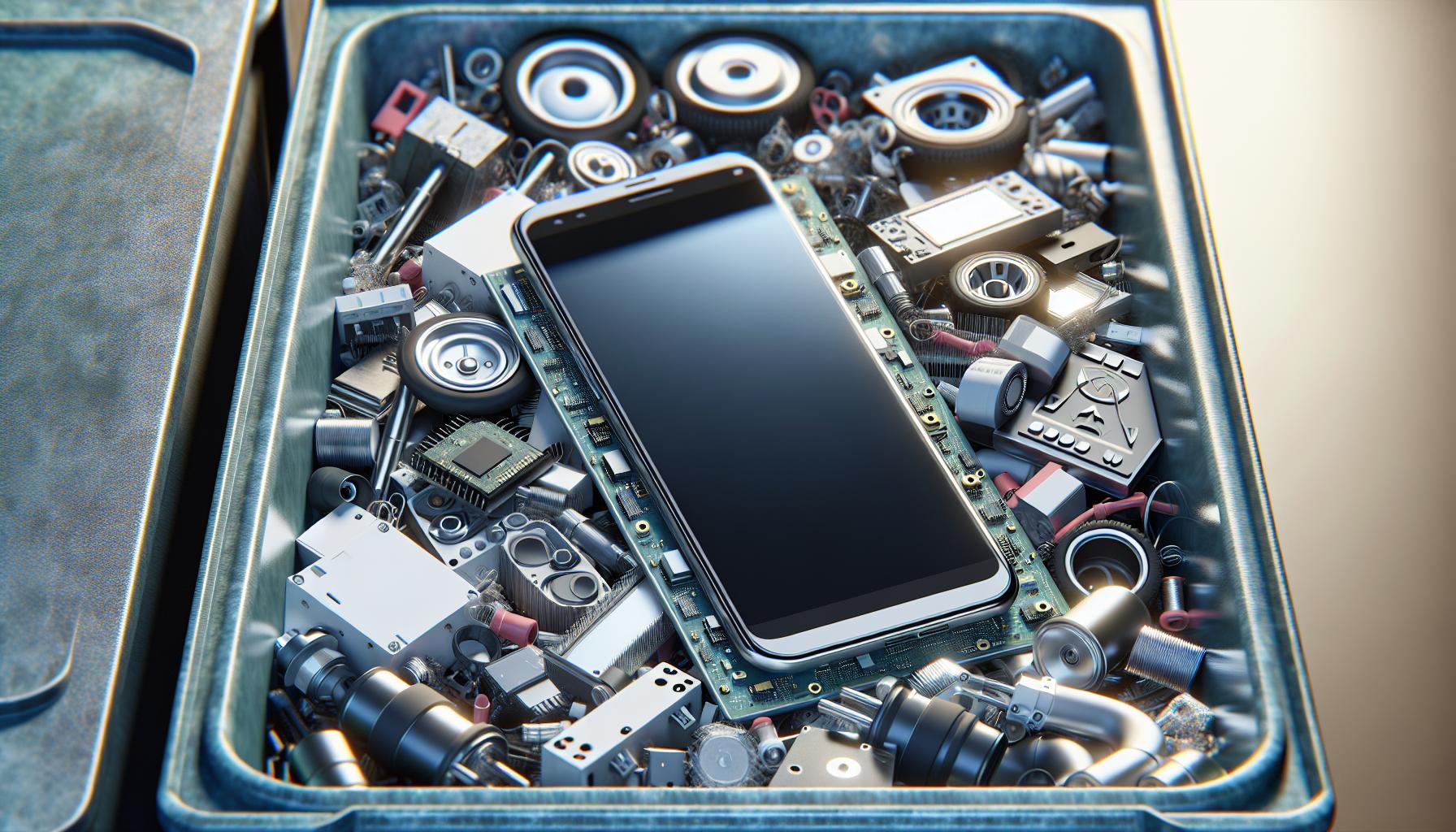As I navigate my daily life, I often find myself reflecting on the technology that surrounds me. Computers and smartphones have become indispensable tools, enhancing productivity and connectivity. However, there’s a hidden danger lurking beneath their sleek exteriors—electronic waste. This growing problem poses significant risks to our environment and health, far beyond the immediate concerns of data privacy or screen addiction.
Every device I dispose of contributes to a staggering amount of e-waste, which often ends up in landfills, leaching toxic substances into our soil and water. It’s alarming to think that the very technology that empowers us could also be a source of profound environmental harm. Understanding the implications of e-waste is crucial, and it’s time we address this critical issue before it spirals out of control.
Key Takeaways
- Understanding E-Waste: Electronic waste refers to discarded devices like computers and smartphones, which if improperly disposed of, can cause significant environmental and health issues.
- Environmental Impact: E-waste contributes to pollution, as toxic materials from devices leach into soil and water, threatening ecosystems and biodiversity.
- Health Risks: Exposure to hazardous substances in e-waste poses serious health risks, particularly for vulnerable populations like children and pregnant women.
- Consumer Behavior: Frequent upgrading and a culture of disposability lead to increased e-waste generation, highlighting the need for responsible usage and recycling practices.
- Mitigation Strategies: Implementing recycling programs, encouraging responsible device usage, and raising awareness about e-waste are essential steps to reduce its impact.
- Future Prospects: Collaborative efforts among consumers, manufacturers, and policymakers, alongside innovative recycling technologies, are vital for effective electronic waste management.
The Greatest Risk In Using Computers And Smartphones Comes From Electronic Waste
Electronic waste, or e-waste, refers to discarded electrical and electronic devices. This category includes computers, smartphones, tablets, televisions, and any other gadgets. As technology advances, e-waste generation significantly increases. In 2021, the global e-waste generated reached 57.4 million metric tons, and this amount is projected to rise by 21% by 2030.
E-waste poses critical environmental hazards. Many electronic devices contain harmful substances like lead, mercury, and cadmium. When improperly disposed of, these materials can leach into soil and groundwater, causing pollution and health risks to nearby communities. According to the World Health Organization, exposure to these toxic elements can lead to various health problems, including neurological damage and developmental disorders.
The recycling and recovery of e-waste play a vital role in mitigating these risks. In 2020, only 17.4% of e-waste was formally recycled worldwide. This low recycling rate highlights the need for increased awareness and effective disposal methods. Proper recycling can prevent hazardous substances from contaminating the environment and recover valuable materials like gold, silver, and copper, helping to conserve resources.
I recognize that addressing the challenge of e-waste requires collaboration among manufacturers, consumers, and policymakers. Implementing stricter regulations for product design and encouraging take-back programs can drive change. In turn, this approach cultivates an eco-friendly culture around technology, fostering a sustainable future.
The Impact of Electronic Waste

Electronic waste poses significant risks, primarily driven by its environmental consequences and health hazards. Understanding these impacts is crucial for fostering responsible technology use.
Environmental Consequences
E-waste contributes to substantial environmental degradation. Landfills overflowing with discarded electronics release toxic substances into soil and water, resulting in serious pollution. In 2021, the global generation of e-waste reached 57.4 million metric tons, with projections estimating an increase to 69.5 million metric tons by 2030. Harmful materials like lead, mercury, and cadmium present in these devices can leach into ecosystems, threatening wildlife and reducing biodiversity. According to the United Nations University, improper disposal of e-waste accounts for about 70% of the toxic elements found in landfills.
Health Risks
Health risks associated with e-waste exposure are alarming. The World Health Organization reports that hazardous substances in e-waste can cause severe health issues, including respiratory problems and neurological damage. Communities near e-waste sites face increased risks as toxic elements seep into their water supply. Young children and pregnant women are particularly vulnerable, as exposure can lead to developmental issues. It’s estimated that electronic waste recycling, without proper safety measures, exposes workers to dangerous levels of toxins, further compounding public health concerns.
Causes of Electronic Waste Generation

Electronic waste generation stems from various factors that I find crucial to understand. Key contributors include consumer behavior and technological advancements.
Consumer Behavior
Consumer habits significantly impact e-waste levels. Many individuals frequently upgrade their devices, often opting for the latest models regardless of their existing electronics’ functionality. For example, statistics reveal that in 2022, 36% of smartphone users replaced their devices within 18 months. This trend leads to a substantial increase in discarded electronics, even when older devices remain operational. Additionally, a culture of disposability fosters neglect for proper disposal practices, resulting in a larger volume of e-waste entering landfills. Educating consumers about responsible recycling and the environmental consequences of improper disposal can help mitigate this issue.
Technological Advancements
Technological innovation plays a dual role in the e-waste crisis. Rapid advancements drive frequent product releases and make older technologies obsolete. In 2021, the average lifespan of smartphones was only two to three years, prompting users to discard fully functional devices for newer iterations. Moreover, the push for higher performance and more features leads to shorter product cycles, creating a constant flow of outdated gadgets that must be managed properly. Incorporating design for longevity and modular components can encourage longer use and reduce the amount of e-waste. Recognizing the advancements’ impacts can enhance efforts to develop sustainable solutions.
Mitigation Strategies

I recognize the importance of taking proactive steps to mitigate the risks associated with electronic waste. Implementing effective strategies can significantly reduce the environmental and health impacts of e-waste.
Recycling Programs
I support the expansion of recycling programs as a crucial strategy against e-waste. Effective recycling programs ensure that electronic devices are properly processed, preventing hazardous materials from contaminating the environment. Many manufacturers offer take-back initiatives, allowing consumers to return old devices for responsible recycling. Implementing local e-waste collection events increases accessibility, encouraging community participation. According to the Global E-Waste Monitor 2020, increasing recycling rates can recover valuable resources, with an estimated $62.5 billion worth of gold, silver, and other materials lost in e-waste in 2019. Encouraging adherence to established recycling guidelines increases the likelihood that e-waste ends up in responsible channels.
Responsible Usage
I advocate for responsible usage of electronic devices to reduce unnecessary e-waste generation. Choosing to repair rather than replace devices extends their lifespan. For example, opting for upgrades like battery replacements and software updates can keep devices functional for longer periods. I also emphasize the importance of purchasing high-quality products designed for longevity and modular components, supporting sustainable consumption. Educating consumers about the environmental impact of frequent upgrades can foster more mindful purchasing decisions. Statistics show that maintaining devices longer can significantly reduce the volume of e-waste produced. Engaging in practices such as sharing or donating functional devices further minimizes electronic waste.
Future of Electronic Waste Management
Developing effective strategies for electronic waste management remains crucial. Implementing comprehensive recycling programs can address the urgent need to process e-waste properly. Programs must focus on educating communities about the importance of recycling, ensuring electronics are disposed of safely.
Investing in innovative recycling technologies shows potential for greater efficiency. Advanced techniques can extract valuable materials from e-waste while minimizing environmental harm. For example, hydrometallurgical methods allow for the extraction of metals like gold and silver with reduced chemical usage.
Encouraging manufacturers to adopt circular economy principles can lead to significant changes. By designing products with longevity and recyclability in mind, companies can reduce waste generation. Implementing take-back schemes enables consumers to return obsolete devices, promoting responsible disposal.
Fostering partnerships between governments, businesses, and nonprofits is essential. Collaborative efforts can enhance awareness and improve recycling infrastructure. Programs that incentivize responsible e-waste disposal can attract participation while educating consumers on environmental impacts.
Monitoring and updating regulations to align with technological advancements also plays a role. Policymakers must address evolving challenges and promote best practices in e-waste management. Creating stricter compliance standards encourages responsible actions across the electronics industry.
Ultimately, proactive engagement and education can greatly influence future electronic waste management. Establishing a culture of sustainability within the tech sector can drive meaningful change while protecting communities and the environment.
Environmental And Health Hazards
The risks associated with electronic waste are far-reaching and demand immediate attention. As I reflect on the convenience of my devices, I can’t ignore the environmental and health hazards they bring. It’s essential for us to take responsibility for how we dispose of our electronics and to push for better recycling practices.
By fostering a culture of sustainability and advocating for responsible consumption, we can mitigate the adverse effects of e-waste. Together, we can create a future where technology enhances our lives without compromising the health of our planet. Let’s make informed choices and contribute to a cleaner, safer environment for everyone.



